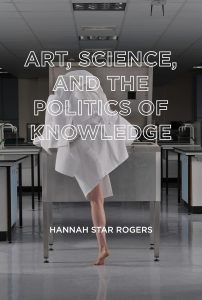In Art, Science and the Politics of Knowledge, Hannah Star Rogers challenges the traditional dichotomy between art and science, arguing that they share common approaches to knowledge-making. Drawing on Science and Technology Studies and using compelling examples, Star Rogers illuminates the overlapping characteristics – such as emphases on visualisation, enquiry and experimentation – of the two knowledge domains, writes Andrew Karvonen.
Art, Science and the Politics of Knowledge. Hannah Star Rogers. The MIT Press. 2022.
 Art and science are often described in oppositional terms. Artists engage in subjective, creative, right-brain activities to produce beautiful objects while scientists use their left-brain skills in objective and methodical ways to improve our collective understanding of the world. In Art, Science and the Politics of Knowledge (The MIT Press, 2022), Hannah Star Rogers challenges and disrupts these dichotomies through a detailed examination of how art and science intermingle and influence one another. She argues that we should set aside the long-standing assumptions about the differences between art and science, and instead recognise their common approaches to knowledge-making.
Art and science are often described in oppositional terms. Artists engage in subjective, creative, right-brain activities to produce beautiful objects while scientists use their left-brain skills in objective and methodical ways to improve our collective understanding of the world. In Art, Science and the Politics of Knowledge (The MIT Press, 2022), Hannah Star Rogers challenges and disrupts these dichotomies through a detailed examination of how art and science intermingle and influence one another. She argues that we should set aside the long-standing assumptions about the differences between art and science, and instead recognise their common approaches to knowledge-making.
[Rogers] argues that we should set aside the long-standing assumptions about the differences between art and science, and instead recognise their common approaches to knowledge-making.
Rogers draws upon Science and Technology Studies (STS) theories and methods to interrogate the overlapping knowledge communities of art and science. Just as STS has been used to destabilise scientific and technological knowledge practices since the 1970s, she argues that it can also be directed towards art and art-science practices. Her social constructivist lens draws upon well-known STS concepts such as Trevor Pinch and Wiebe Bijker’s notion of interpretive flexibility, Geoff Bowker and Susan Leigh Star’s emphasis on the power of classification, and Bruno Latour’s immutable mobiles to reveal the multiple ways that art and science are indelibly intertwined. She follows scientists and artists in their laboratories, studios and exhibition spaces to develop ethnographic evidence of the commonalities and synergies between their knowledge practices.
Just as STS has been used to destabilise scientific and technological knowledge practices since the 1970s, she argues that it can also be directed towards art and art-science practices.
Rogers’ first two case studies are based on archival studies of artists who contributed to scientific knowledge production. From the 1880s to the 1930s, the father and son team of Leopold and Rudolf Blaschka used their artisanal expertise in glassmaking to represent wonders of the natural world, notably sea creatures and flowers. Rogers argues that these models were not simply representations of the natural world but contributed to scientific knowledge in substantive ways. As she writes,
To create three-dimensional, detailed representational objects, the Blaschkas had to do their own studies and observations, and in doing so they were creating new ways of knowing sea creatures that would otherwise have been represented by flaccid specimens in jars or two-dimensional drawings. The knowledge that these artisans created was a method of displaying the salient features of marine life to the satisfaction of the scientific community (47). In other words, the Blaschkas positioned themselves as co-producers of scientific knowledge and their models provided new ways of seeing and knowing the field of natural history.
The Blaschkas positioned themselves as co-producers of scientific knowledge and their models provided new ways of seeing and knowing the field of natural history.
The power of visualisation is reinforced in Rogers’ second case study of the renowned 20th-century photographer Berenice Abbott. In the 1940s, Abbott developed a photo-realist technique that could accurately depict physical science laws and principles. She worked in close collaboration with scientists to stage images of soap bubbles, magnetic filings, light traveling through prisms, and falling objects such as balls and wrenches. These images were prominently displayed in science textbooks and were used to inform the scientific literacy of the general public. The realist photos of Abbott and the lifelike glass sculptures of the Blashckas extend earlier STS scholarship by Latour, Michael Lynch, Steve Woolgar, and others on the centrality of images and models to scientific knowledge making while also highlighting their aesthetic achievements. These artefacts are simultaneously works of science and works of art.
The fourth case study of tactical media is an outlier in the book. Tactical media is a social activist movement that emerged in the 1990s as subversive individuals began to employ the World Wide Web for political messaging. Rogers describes various performative, ephemeral interventions to critique capitalism and challenge authority through disinformation, humour, playfulness, and creativity. The case study provides fascinating insights about how technical artefacts can be used to promote alternative ways of knowing, but the work of tactical media practitioners has tenuous connections to the art-science thesis in the rest of the book.
Bioartists shared laboratory space, techniques, and materials with scientists to do science while also critiquing it.
Rogers’ fourth case study returns to the art-science knowledge nexus with an ethnographic study of SymbioticA, a laboratory for the biological arts at the University of Western Australia in Perth. She shadowed the activities of bioartists who collaborate with biotechnologists to develop interactional expertise and expand the knowledge domain of biotechnology. The bioartists shared laboratory space, techniques, and materials with scientists to do science while also critiquing it. As she notes, “Bioartists have seen themselves not as the mediators of scientific knowledge to the public but as the producers themselves” (145). The case study provides vivid examples of how artists and scientists contribute to the hybrid field of art-science in novel ways.
[Rogers] makes a compelling case for using exhibitions in art galleries and libraries to promote STS ways of knowing and to frame research activities as a collective intervention.
In her final case study, Rogers transforms from observer to action researcher by curating an art-science installation titled “Art’s Work in the Age of Biotechnology: Shaping Our Genetic Futures” at North Carolina State University in 2019 and 2020. The exhibition included objects with accompanying videos to create an open-ended, iterative, and interactive space where scientists, artists, and the general public could come together in a shared dialogue on biotechnology and society. She makes a compelling case for using exhibitions in art galleries and libraries to promote STS ways of knowing and to frame research activities as a collective intervention. As she notes, “Curators create new knowledge around objects by analyzing the layers of meaning added to them in different context[s]” (245).
While Rogers’ description of the curatorial process provides a titillating glimpse on how STS ideas can be mobilised in new ways, it also raises important questions about the role of the public in knowledge production processes. In the case study, she frames the public as critics rather than pupils of art-science knowledge production, but her description of the curated exhibit includes no evidence on how the public contributed to this shared dialogue. This omission highlights the long-standing challenge of transcending the boundary between experts and non-experts to co-produce knowledge through more democratic forms of engagement.
Rogers provides a wealth of compelling examples to reveal the networked production of art-science knowledge that enrols people, artefacts, and ideas in studios and laboratories through complementary modes of questioning and experimentation.
Overall, the case studies in this book illustrate how art and science are distinct yet overlapping knowledge domains with multiple commonalities. Rogers provides a wealth of compelling examples to reveal the networked production of art-science knowledge that enrols people, artefacts, and ideas in studios and laboratories through complementary modes of questioning and experimentation. The findings make a compelling case for how an STS perspective can be used to deconstruct and critique knowledge domains that extend far beyond scientific and technological development.
This post gives the views of the author, and not the position of the LSE Review of Books blog, or of the London School of Economics and Political Science. The LSE RB blog may receive a small commission if you choose to make a purchase through the above Amazon affiliate link. This is entirely independent of the coverage of the book on LSE Review of Books.
Image Credit: Museopedia on Wikimedia Commons.








2 Comments